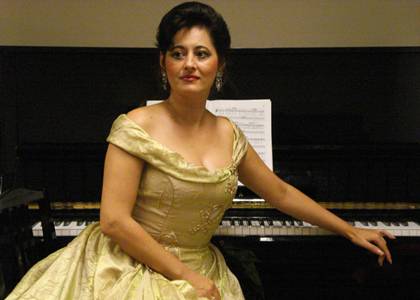> [Archived] Chronicles

Two 'Names' and a Philharmonic Performer
It was something that I experienced at the Athenaeum last evening , where I expected that the public would be attracted by the poster which had two 'names' on it - Fischer-Dieskau and Menuhin - because it was the son of the famous baritone - Martin - who was at the stand and Jeremy - the son of the legendary violinist - who played the piano; taking all this into account, as well as the generous description published on their website, without even mentioning the soloist Aura Twarowka - the mezzo-soprano who was far superior to them.
The repertoire included great German compositions , with a powerful Romantic touch, was also extremely tempting both for the performers and for the public, but since the orchestral introduction to Brahms's Piano Concerto No. 1 in D minor I was surprised not only by the uniformity of the conductor's gestures, his hands moving invariably up and down, but also by the lack of emotional vibration and slowness which were to characterize Martin Fischer-Dieskau's whole 'perspective'; the pianist Jeremy Menuhin was not up to the score's magnitude, which was conscientiously played, with a precise technique, but having no amplitude and real expressiveness, his fingers just running over the keyboard. It was a dull and faded performance with no consistency, played in a tempo which made no room for a potential density or construction of the phrase, even if the Philharmonic's Orchestra sound was homogenous and somehow tried to compensate for that dull attempt which lasted almost an hour, more than any acceptable version; the fact that the public's applauses were quite restrained and they did not request an encore spoke for itself and showed that the artist was not very persuasive . Keeping the same Brahmsian direction, but also that of the extremely diffused tempos, the Alto Rhapsody for male chorus and orchestra was the perfect occasion for Aura Twarowska - an artist who has been singing for many years at the Vienna State Opera and who greatly deserves to be constantly invited in the current season - to come back on stage; her generous, rich voice, very elegantly and expressively conducted, gave a 'high line' to the musical phrasing as well as to the meaning of the text, to the audience's delight who finally enjoyed listening to a splendid, deep and grave voice, perfectly adapted to a beautifully written piece that managed to balance with the choral ensemble (trained by Iosif-Ion Prunner) and solved the issues caused by that slow tempo. However, what followed next was Strauss's tone poem, Death and Transfiguration, which the conductor treated in a similar way, perhaps with a slightly diverse gesture, but keeping the same monotone pattern; fortunately, the music itself enabled some dramatic sequences which, when played forte, had a vibrant sound and a particular width; meditation or calm moments were, however, flat, without uniformity, even though the title is related to… transfiguration! It's true that Martin Fischer-Dieskau conducted the whole performance without a score, which proved just the fact that he had a good memory and not real knowledge of each composer's style, ideas or special features; as far as the lack of emotion, dedication, interpretation concerns…
As it was announced, the public met with famous names at the Philharmonic, but unfortunately they were just names, because the sons inherited nothing from those things that made their father famous. Despite their magnificent resume, the reality says something else…
Translated by Georgiana Ursu and Elena Daniela Radu
MTTLC, the University of Bucharest














